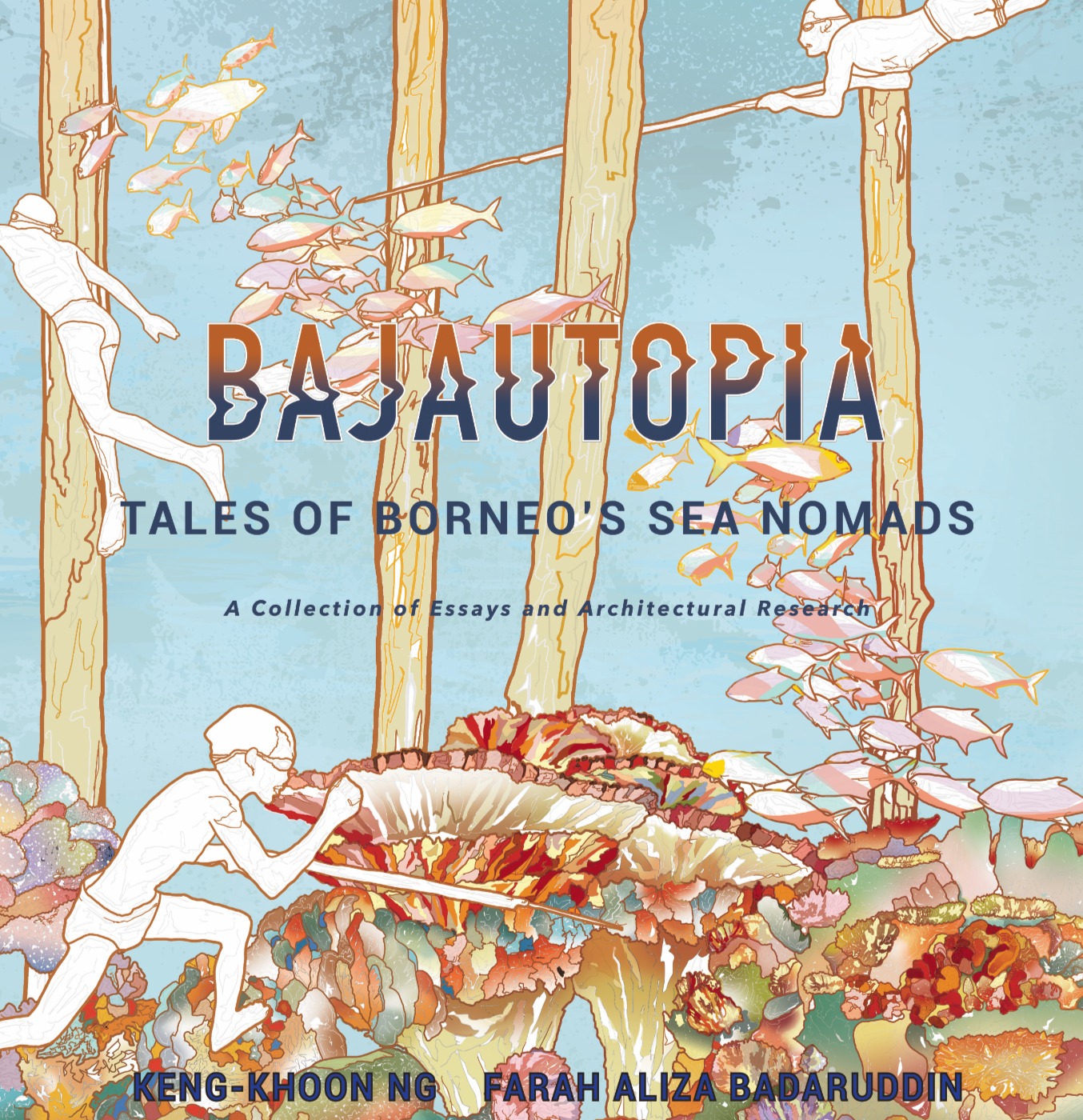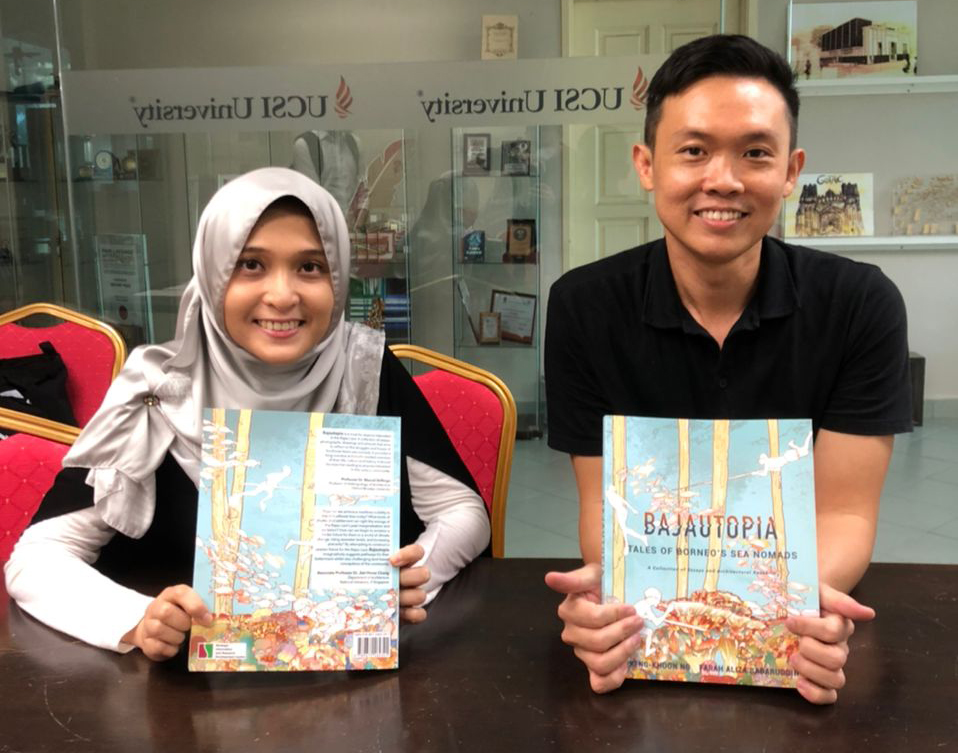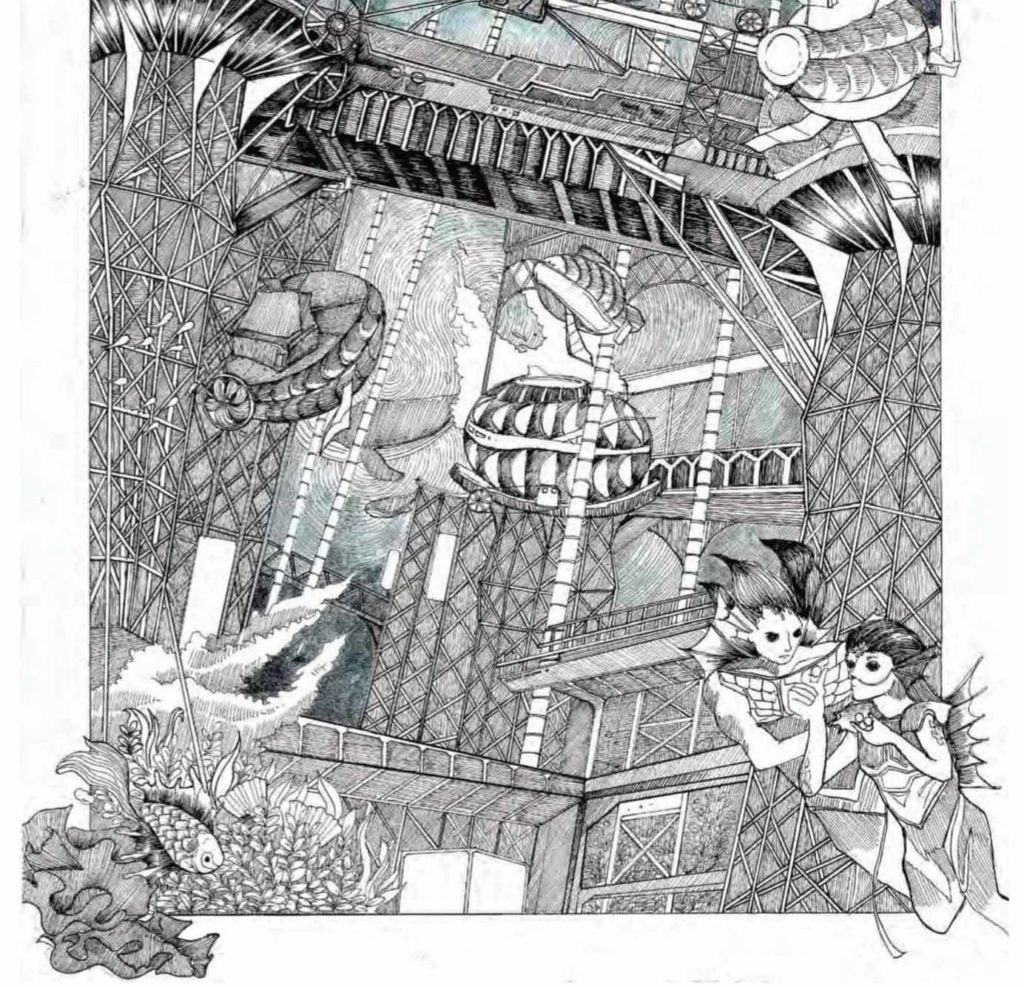
'Bajautopia' is a book that celebrates architecture students’ speculative and imaginative proposals for the future of the Bajau Laut community.
Story and photos by YUSRA ZULKIFLI for LENSA SENI
As you wander through the bookshelves of Kinokuniya in Kuala Lumpur City Center (KLCC), a striking cover with the title Bajautopia – Tales of Borneo’s Sea Nomads may capture your attention. The cover stands out, illustrating three human figures spear fishing in a rich, diverse marine ecosystem.
The 182-page book explores new and imaginative architectural proposals for the Bajau Laut in Kampung Bangau-Bangau, Semporna, Sabah. Rich visualisations of the architectural students’ works are interwoven with writings by scholars and individuals from a wide range of disciplines.

Bajautopia: Tales of Borneo’s Sea Nomads, is a newly published collection of essays and architectural research by the School of Architecture and Built Environment (SABE), UCSI University, led by Dr Ng Keng Khoon and Ar. Farah Aliza Badaruddin, who are also the book’s editors.
The Bajau Laut are nomadic seafarers. For centuries, they lived in boathouses traversing the waters of the Sulu Archipelago. However, the formation of borders has made their nomadic way of life unsustainable, and the majority of the Bajau Laut have since been forced into a more sedentary lifestyle.
There are 20 students’ imaginative proposals for the Bajau Laut intertwined with 11 diverse essays on the Bajau way of life written by anthropologists, a filmmaker and researchers in politics, visual arts, tourism and architecture..
“We wanted the students’ architectural proposals to be part of a larger dialogue side by side with social and political backgrounds, and at the same time, still be very much readable,” said Ng.

Ng added, “We never planned for the book to be the outcome of our research. However, during the final critique of the architectural students’ presentation in December 2020, we received many positive and encouraging comments from our external reviewers. These reviewers are experts on the Bajau Laut diaspora.
“One day, after reviewing and marking students’ work, Farah and I sat down to reflect on the work we did over the semester. Why not turn the research and the students’ work into a book?”
Seldom do we find students’ work, particularly that of degree students, turned into a book that situates a dialogue within the context of a larger issue, such as that faced by the Bajau Laut. Rarer still are architecture schools that pay attention to these marginalised groups.
As Professor Tajuddin Rasdi concludes in his essay: “The Bajau Laut may serve as an important case for a different kind of economic model that does not uproot nor destroy a community, as has happened repeatedly around the world since the Industrial Revolution.”
He adds, “The curriculum must be constructed differently: moving towards a sustainable economic construct, supporting traditional lifestyle and livelihood”.
Current architectural school education caters to urban livelihoods, which differs significantly from rural development.

Rural development needs long term engagement with a society that embraces a different economic model, one that allows the community to adopt sustainable traditions and way of life. This was Ng and Farah’s direction, imploring their students to think critically and imaginatively while being mindful of the Bajau Laut’s traditional way of life.
Farah shares her design studio’s direction in her essay. “It is every individual’s responsibility to foster cooperation in remedying environmental damage that has impacted the built environment in Sabah. A collaborative effort is required between agencies, architects and native people to build responsive and resilient architecture, by sharing benefits, resources, and indigenous knowledge from Bajau culture and customary practices. It is hoped that new methods of sustainable architecture in the maritime context will empower and alleviate the plight of the Bajau Laut and enable a better quality of life.”
For example, in The Moving Bajau proposal, Bajau houses can move from land to sea, creating a “moving city” of Bajau dwellers, giving them the freedom to moor or roam the seas and embrace their ancestors’ way of life.
There are three main themes in the book that structure the students’ imaginative conceptual proposals, stemming from their final year architectural design studio brief. The first is Reimagining Nomadic Lifestyle, which begins with a photo essay by Erik Abrahamsson illustrating the Bajau Laut way of life.
“The inclusion of Erik’s work was fundamental, as the pandemic hampered our research trip. We had limitations in the presentation of the Bajau Laut themselves, but Erik’s amazing photographs helped facilitate the gap,” said Ng.
Additionally, Ng and Farah engaged Borneo Komrad – an NGO based in Kampung Bangau-Bangau that provides education to stateless Bajau Laut children – to share local information that proved instrumental in sharing local information developing the students’ briefs.
Second, Re-enacting the Right to the Ocean discusses the challenges faced by the Bajau Laut in terms of social, political and environmental issues. Finally, Rethinking Sabah and Bajau Laut reflects how one can sustainably empower the marginalised Bajau Laut through welfare, education and tourism.

“It is interesting to see the potential of an architecture school be part of the social and political debate and contribute to the dialogue that politicians, economists or sociologists usually lead,” reiterated Ng. Of course, there is always a tendency for architects to offer solutions to problems. Still, the students’ works here are future visions that are speculative, and help in creating awareness of the community.
On top of creating awareness, Ng and Farah decided that the book project would be a non-profit publication, with profits going to Borneo Komrad. The book can be purchased through USCI University. It has been a humble project made possible by the dedication of lecturers such as Ng and Farah, working alongside a fantastic group of students with a shared vision.
“We hope that the book reaches a balanced audience . We are not hoping for immediate contributions, but rather, we want to plant seeds of hope,” said Ng.
The lecturers’ direction perhaps shares the same sentiment as Borneo Komrad’s Sekolah Alternatif philosophy, “Education is a tool to transform society. Once they gain knowledge, they have to give back to others.”
Ng and Farah’s modest and honest approach serves as a model of shared knowledge for their students. It appreciates their students’ research and ideas, allowing them to be part of the dialogue surrounding the Bajau Laut diaspora.
YUSRA ZULKIFLI is a participant in the CENDANA ARTS WRITING MASTERCLASS & MENTORSHIP PROGRAMME 2021
The views and opinions expressed in this article are strictly the author’s own and do not reflect those of CENDANA. CENDANA reserves the right to be excluded from any liabilities, losses, damages, defaults, and/or intellectual property infringements caused by the views and opinions expressed by the author in this article at all times, during or after publication, whether on this website or any other platforms hosted by CENDANA or if said opinions/views are republished on third party platforms.
